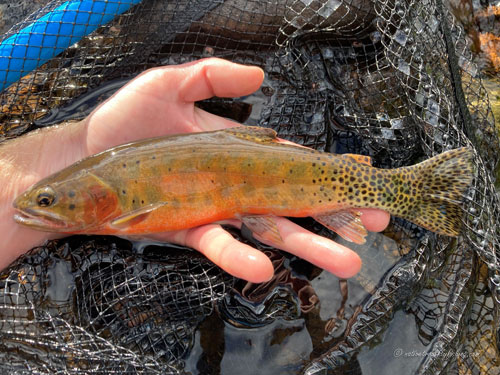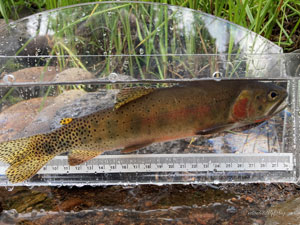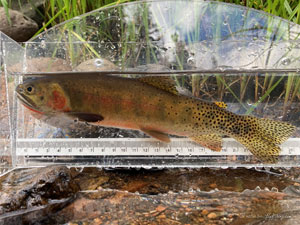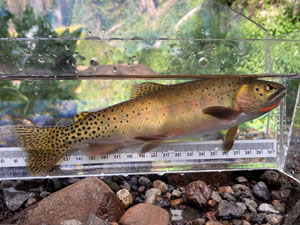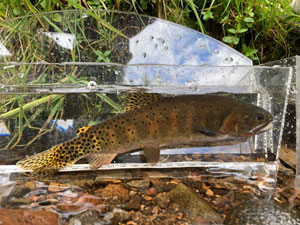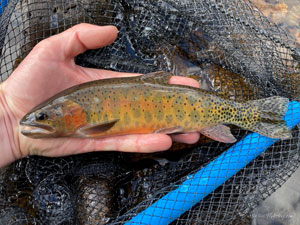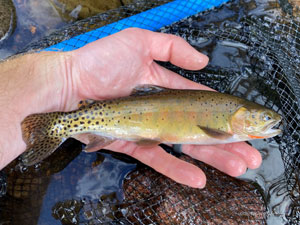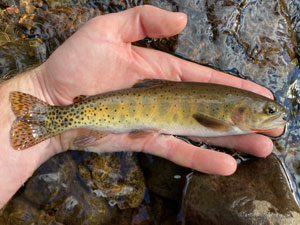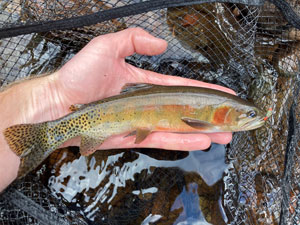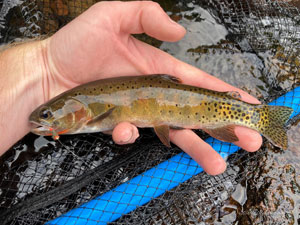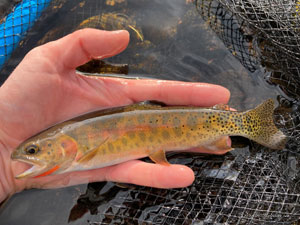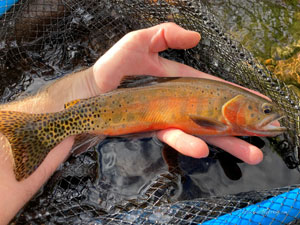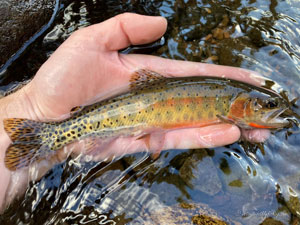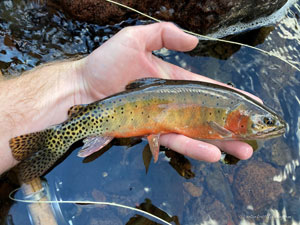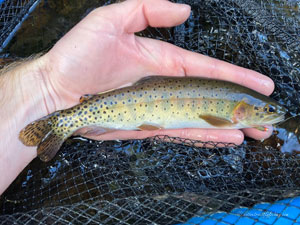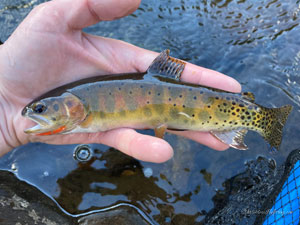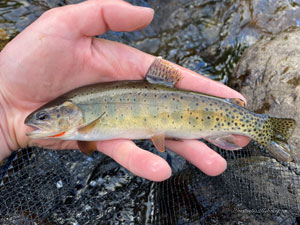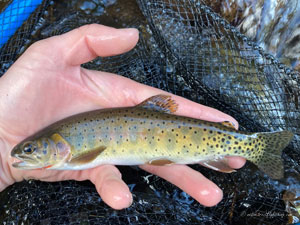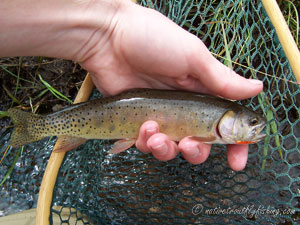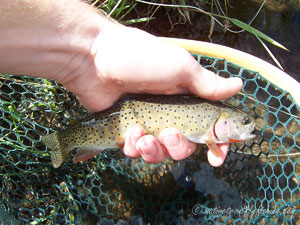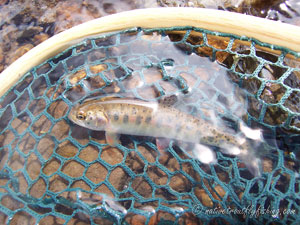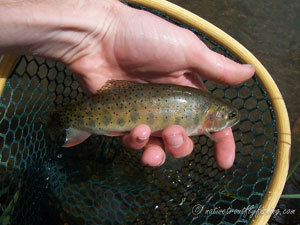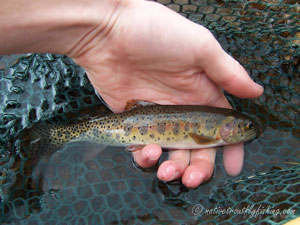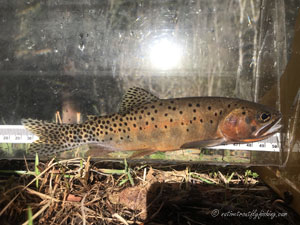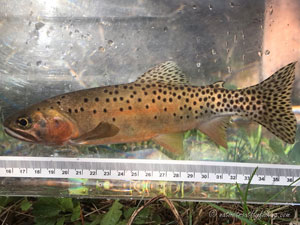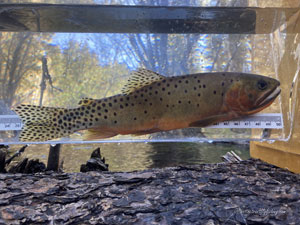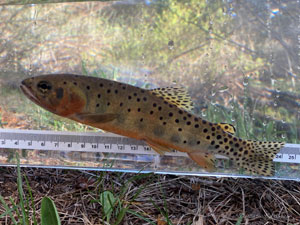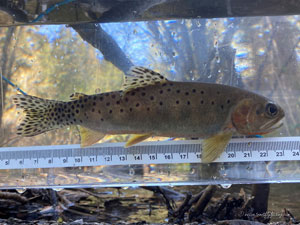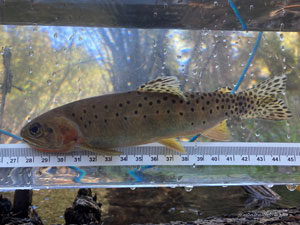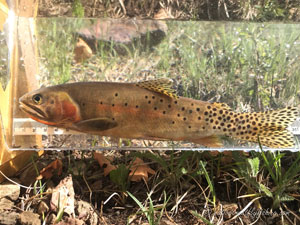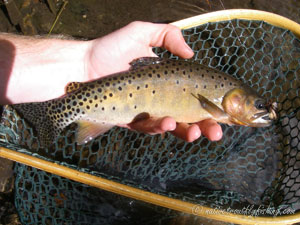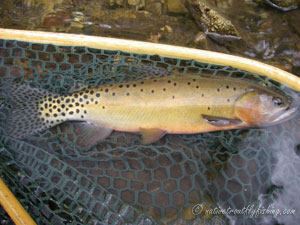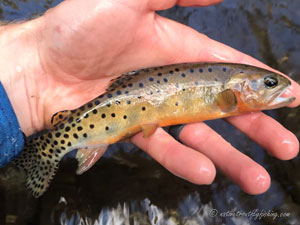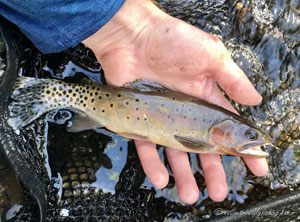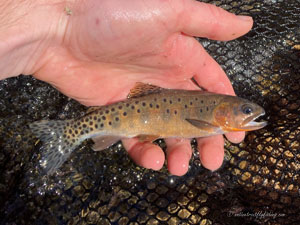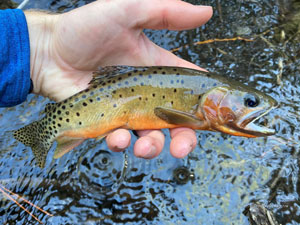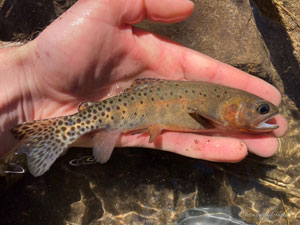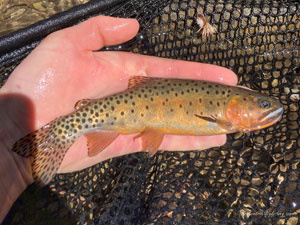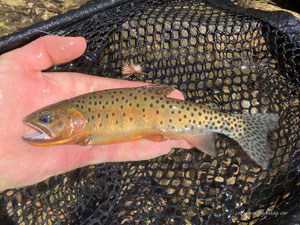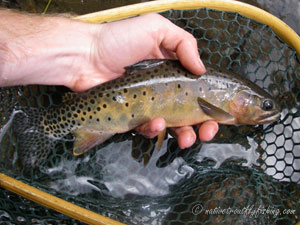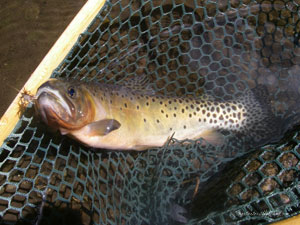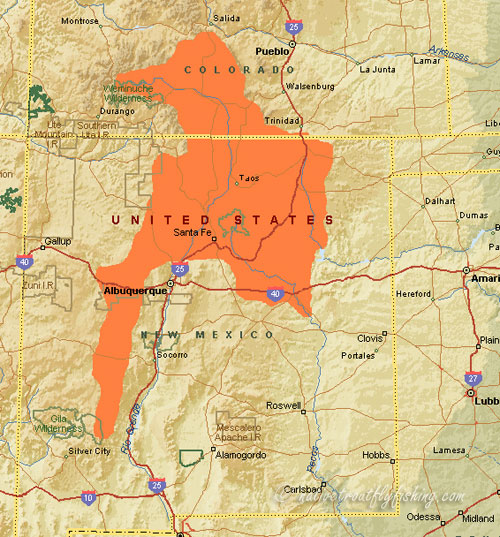Rio Grande Cutthroat
Oncorhynchus clarki virginalis
A large spotted Rio Grande Cutthroat from a small stream in Colorado.
Introduction
The Rio Grande Cutthroat was the first trout to be discovered in North America by Europeans and was described in 1541 by member of Coronado’s expedition crossing the Southwest of what is now the United States in search of gold (Trotter and Bisson 1988). This beautiful trout is considered a subspecies of the Rocky Mountain Cutthroat (Oncorhynchus virginalis) and is found in the Rio Grande, Canadian and Pecos River drainages of New Mexico and Colorado (Trotter et al. 2018). It is unclear if the populations in the Canadian drainage are native or not, as the watershed drains to the Arkansas River and not the Rio Grande (Behnke 2002), but genetic evidence suggests that they are native and likely reached the Canadian watershed from a headwater transfer from the Pecos drainage (Pritchard et al. 2009). Rio Grande Cutthroat have the distinction of being the southernmost subspecies of Cutthroat Trout. However, due to the loss of populations across their native range and reports of Rio Grande Cutthroat in Mexico and Texas, it is unclear how far south this trout once occurred. The Mexican reports have been all but dismissed with the discovery of the Rio Conchos Trout (Hendrickson et al. 2006), but Garrett and Matlock (1991) provided evidence indicating that Rio Grande Cutthroat were likely native to the Davis Mountains of Texas. Within the Rio Grande Cutthroat subspecies, the trout from the Pecos watershed are genetically and phenotypically unique, having larger spots than what is typical of populations in the Rio Grande drainage (Garrett and Matlock 1991, Trotter 2008, Pritchard et al. 2009). Today the southernmost known populations are located on the eastern flanks of the Gila Mountains in Southern New Mexico.
Life History Information
The Rio Grande Cutthroat historically occurred as stream resident, fluvial and adfluvial populations, although they are primarily confined to fragmented stream resident populations today. As there are no large lakes within the native range of the Rio Grande Cutthroat, the adfluvial life history is relatively rare within the subspecies and the stream resident and fluvial forms predominated. However, there no large, interconnected populations of Rio Grande Cutthroat remaining today, and as such it is believed that the fluvial life history is no longer expressed. Due to this, what we know about the life history of Rio Grande Cutthroat primarily comes from historic accounts of the fluvial populations or from the remaining stream resident populations. According to Behnke (2002) these trout are thought to have a life span of between five and eight years, with stream dwelling populations generally reaching a maximum size of around 15" or 16" (38 to 41 cm). However, historic accounts suggest that fluvial Rio Grande Cutthroat once reached much larger sizes, with 4 lb. (1.8 kg) trout not considered unusual and fish up 26” (66 cm) and up to 11 lbs. (5 kg) documented from the mainstem Rio Grande River (Hough 1888). As with other subspecies of Cutthroat, the Rio Grande Cutthroat a spring spawning fish and spawning occurs as runoff subsides, typically between the middle of May and July depending on the water temperature and elevation (Rinne 1995, RGCTCT 2013). Males typically spawn for the first time at age-2, while females generally spawn when they reach three years old at a size of between 4" and 10" (10 to 25 cm) (Trotter 2008), although some may not spawn until age-4 or age-5 (RGCTCT 2013). Juveniles typically emerge by mid-August and utilize stream margins with slower and warmer water as nursey habitat. As Rio Grande Cutthroat get larger, they primarily use pools with sufficient cover and riffles as foraging habitat (RGCTCT 2013). Rio Grande Cutthroat are known to be generalists and incorporate both aquatic and terrestrial insects into their diet. However, a study done by Shemai et al. (2007) indicated that small larval caddis flies, which are more energy dense than other larval aquatic insects tend to make up the bulk of their diet. Once the reach a large enough size and when available, Rio Grande Cutthroat may also prey on smaller fish such as Rio Grande Sucker. Like other trout, Rio Grande Cutthroat require streams with cool water and ample riparian cover and in-stream structure (boulders and woody debris). Harig and Fausch (2002) also indicated that stream gradients of less than 10% are required in Rio Grande Cutthroat habitat and that they need pools deeper than 6" (15 cm) as refugia during periods of drought and to overwinter. While rare today, is likely that the adfluvial life history was once more prominent, as Rio Grande Cutthroat fossils have been found in the sediments of ancient Lake Estancia in New Mexico (Behnke and Platts 1990). The few adfluvial populations that do exist are found in small alpine lakes. While no formal life history studies have been conducted on adfluvial populations of Rio Grande Cutthroat, these trout require inlet or outlet stream habitat for spawning and like stream resident fish they appear to be generalist feeders but are able to reach larger sizes of up to 20” (51 cm).
Status
Like other interior Cutthroat subspecies, the Rio Grande Cutthroat has experienced significant declines across its native range over the past century and is now only found in about 11% of its native range, with 90% of remaining populations isolated from each other (Bakevich et al. 2019). The significant decline of Rio Grande Cutthroat led to them being petitioned to be listed as threatened under the Endangered Species Act (ESA) in 1998 and has resulted in a long series of legal battles to list it under the ESA (SCBD 1998). After a determination that the listing was not warrant and a subsequent appeal, the USWFW determined the Rio Grande Cutthroat warranted a listing under the ESA in 2008 and the subspecies was added to the USFWS candidate list (USFWS 2002, USFWS 2008). After again reviewing the status of the Rio Grande Cutthroat in 2014 the USFWS again determined that listing the Rio Grande Cutthroat was not warranted (USFWS 2014). This decision was also appealed, and the Rio Grande Cutthroat has since been returned to the candidate list (USFWS 2023).
Rio Grande Cutthroat have been plagued with the same set of problems as other subspecies of Rocky Mountain Cutthroat Trout, including habitat destruction, over-harvest and most notably the introduction of nonnative fish. Early accounts of the upper Rio Grande River, indicate there were large-scale commercial fisheries for trout were operating to supply the mining camps and the growing frontier communities of Colorado and New Mexico. Additionally, as the agricultural footprint in the upper watershed increased, unscreened irrigation ditches became a significant issue, and it was noted that when the water for irrigation was turned off that dead trout were shoveled out by the wagonload (Hough 1888). As a result, by the late 1880’s Rio Grande Cutthroat populations were already in decline and in short order the introduction of non-native species became an appealing way to supplement the dwindling fishery. There are currently 39 fish species found in the upper Rio Grande watershed, but only 5 of these are native, while the remaining 34 where introduced (Calamusso et al. 2005). While Rio Grande Cutthroat are believed to have once inhabited approximately 6,660 miles (10,718 km) of stream habitat across Colorado and New Mexico, conservation populations (>90% genetically pure) are currently only found in around 752 miles (1,210 km) of habitat (Bakevich et al. 2019). Since 2008, five additional conservation populations have been lost due to a combination of severe drought conditions, hybridization, or invasion by non-native trout species (Bakevich et al. 2019). Due to the relatively close relationship between Rainbow Trout and Cutthroat Trout and the fact that both species spawn in the spring, Rio Grande Cutthroat are highly susceptible hybridization with introduced Rainbow Trout. This has resulted in the loss of many populations and based on genetic sampling and stocking records, it is believed that pure populations of Rio Grande Cutthroat only found in between 58% to 71% of their remaining habitat (Alves et al. 2008). While Rainbow Trout have had a major impact on Rio Grande Cutthroat, Brown Trout are the most common nonnative trout throughout the Rio Grande basin and have also had a substantial impact. In addition, Brook Trout were planted in many higher elevation streams. Both Brook Trout and Brown Trout spawn in the fall and as such do not hybridize with Rio Grande Cutthroat. Instead, they exert competitive and predatory pressures on Rio Grande Cutthroat, often replacing them completely. Shemai et al. (2007) showed Rio Grande Cutthroat inhabiting a stream with Brown Trout, had a lower body fat content and had a much different diet than Rio Grande Cutthroat found in streams without Brown Trout. The Cutthroat in these studies also showed fin damage in the presence of Brown Trout suggesting aggressive territorial behavior by the Brown Trout. While Rio Grande Cutthroat may opportunistically prey on small fish, Brown Trout become highly piscivorous once they get large enough and often prey on juvenile Cutthroat. There are some populations where Rio Grande Cutthroat and Brown Trout appear to be coexisting, but the two species generally partition their use of habitat, with the Brown Trout utilizing the warmer more productive lower reaches of the streams, while the Cutthroat are confined to the colder headwaters. An additional challenge to managing streams where both Rio Grande Cutthroat and Brown Trout are found is the fact that Cutthroat are much more susceptible to angling than Brown Trout. As a result, when harvest is allowed, it can have a significant effect on the Cutthroat population, while having a minimal effect on Brown Trout, allowing them to dominate the watershed (Behnke 1992). Nonnative fish removals are costly, complicated, and often controversial and as such nonnative trout are likely to present a significant threat to Rio Grande Cutthroat for the foreseeable future. For example, as Brown Trout are a popular game fish across Colorado and New Mexico, most efforts to remove them have been confined to smaller streams with limited angling interest, but also limited recovery potential for Rio Grande Cutthroat. One of the more common management strategies to protected Cutthroat populations from invading nonnative trout, is the use of artificial barriers that prevent nonnative fish from moving upstream into the Cutthroat habitat. However, this comes with several consequences including reducing access to more productive downstream habitat, a lack of connectivity with other populations, and reduced genetic diversity (Pritchard et al. 2007).
While the introduction of nonnative trout is the single largest threat to the Rio Grande Cutthroat, habitat destruction has also had a major impact. Mining, timber harvest, irrigation and overgrazing can all be credited with contributing to the degradation of the Rio Grande Cutthroat's habitat and as such, 43.3% of streams containing Rio Grande Cutthroat are considered to have degraded habitat today (Alves et al. 2008). As with many other trout in arid environments, overgrazing by cattle has resulted a loss of crucial riparian vegetation stream incising, and a loss of habitat complexity. The loss of riparian vegetation has also resulted in increased sedimentation and higher summertime stream temperatures, which can lead to spawning failures, decreased growth and mortality of Rio Grande Cutthroat. At high altitudes loss of riparian vegetation also leads to the formation of stream anchor ice in the winter, which can greatly reduce the available winter habitat and lead to increased spring scour (Rinne 1995). To compound the habitat degradation issues, climate change is also having a significant impact on Rio Grande Cutthroat, resulting in drier hotter summers and increased forest fires. A recent assessment found that86 percent of Rio Grande Cutthroat populations are at high to extreme risk of wildfire (TNC 2013). In 2022 the Calf Canyon-Hermits Creek Fire became the largest wildfire in New Mexico history and impacted nine Rio Grande Cutthroat streams resulting in the complete loss of one population. This wildfire also necessitated a costly fish rescue from Rito Morphy, in which biologist rushed in to electroshock 190 Cutthroat before the fire hit the stream. These Cutthroat were then transplanted into another stream, as Rito Morphy’s habitat is expected take years to recovery. While wildfires represent a grave threat to Rio Grande Cutthroat, in some cases forest fires have also made way for the restoration effects, after ash or debris flows eliminated the populations of nonnative trout (Bakevich et al. 2019). Wildfires aren’t the only impact of climate change, and an analysis of climate data from the past 45 years, indicates that climate change has already resulted in increased air temperatures and snowmelt shifting 10.6 days earlier (Zeigler et al. 2012). This has resulted in increased flows during the winter and the spring spawning season and decreased flows throughout summer. The change in flows and temperatures is expected to impact the life history patterns and distribution of Rio Grande Cutthroat, as well as enable non-native trout to invade further upstream into Rio Grande Cutthroat habitat as stream temperatures warm. As a result, it is currently predicted that only 11% of the remaining 121 (as of 2008) Rio Grande Cutthroat conservation populations will have a greater than 75% chance of persisting to the 2080’s if nothing is done, with the biggest impact to populations where nonnative trout are already present (Zeigler et al. 2019).
Despite the uncertain future for the Rio Grande Cutthroat, some progress is being made to restore them to their native range. In 2021, Rio Grande Cutthroat were reintroduced to the Sand Creek watershed in Great Sand Dunes National Park, restoring them to the entirety of the 32 square mile (82.8 square km) watershed, which includes three small lakes that are expected to support fish exhibiting an adfluvial life history (McGee et al. 2019). Significant progress has also been made to restore Rio Grande Cutthroat to the Rio Costilla watershed in Valle Vidal, New Mexico, a project which has been going on for over 30 years now. While the initial project was only focused on restoring Rio Grande Cutthroat to segments of the watershed, such as Comanche Creek, it was expanded to the entire watershed, with a major fish barrier built on the lower reach of Rio Costilla to bar access to non-native salmonids. The project is nearing completion with fish being planted during the summer 2023, and when all is said and done Rio Grande Cutthroat will have been restored to 120 miles (193 km) of their historic habitat, as well as 16 lakes and one reservoir and allowing for the potential reemergence of a fluvial life history strategy in the watershed. As a result of these and other substantial restoration efforts, Rio Grande Cutthroat saw a significant increase in their occupied habitat between 2006 and 2016, with 8 new conservation populations established and across an additional 53 miles (86 km) of stream habitat (Bakevich et al. 2019). With the vulnerability of Rio Grande Cutthroat to climate change and further invasion by non-native trout, restoration efforts such as those at Valle Vidal and Sand Creek and the fact that we are now gaining ground faster than we are losing it, provide hope that these beautiful trout will have the resilience to persist for future generations to enjoy despite changing environmental conditions.
Description
Among the subspecies of Cutthroat Trout found in the southern Rocky Mountains, the Rio Grande Cutthroat is the most phenotypically distinct (Rogers et al. 2018). Like the Colorado River Cutthroat, the Rio Grande Cutthroat is often brilliantly colored, although a more somber coloration tends to be more common. The coloration of these fish is typically a brownish-yellow or greenish-bronze tone over the back transitioning to a brassy-yellow or bronze color along the sides. Sexually mature fish often display more brilliant colors with some fish displaying bright red or orange along their belly. Some individuals also have a pink or orange color along their lateral line and the gill plates are generally a rosy or bright orange color. There are two major spotting variations across the native range of the Rio Grande Cutthroat, with fish from the Pecos River watershed displaying some of the largest spots of any Cutthroat, which are concentrated towards above the lateral line and towards the caudal fin. Rio Grande Cutthroat tend to be slightly more profusely spotted with moderate sized round spots. Juveniles typically display 7 to 10 oval-shaped parr marks along their sides, which fade as fish reach maturity and an orange or red colored cutthroat mark is found under their jaw.
Taxonomic Characteristics: Gill rakers average 18.7, with a range of 17-21. Pyloric Caeca average 41, with a range of 32-49. Scales along lateral line average 182, with a range of 169-209. Basibranchial teeth average 6, with a range of 0 to 12 (Bestgen et al. 2019).
Stream Resident Form - Rio Grande Drainage
Click on images to view a larger picture
Native Range
A map of the original native range of the Rio Grande Cutthroat. Data Source: Behnke (2002) and Trotter (2008).
References
Alves, J.E., K.E. Patten, D.E. Brauch and P.M. Jones. 2008. Range-wide status of Rio Grande cutthroat trout (Oncorhynchus clarki virginalis): 2008. Colorado Division of Wildlife, New Mexico Department of Game and Fish, U.S. Forest Service, U.S. Fish and Wildlife Service, Bureau of Land Management, National Park Service and Jicarilla Apache Nation.
Bakevich, B.D., R.J. Paggen and B.W. Felt. 2019. Range-wide status of Rio Grande cutthroat trout (Oncorhynchus clarki virginalis): 2016. Rio Grande Cutthroat Trout Conservation Team Report. New Mexico Department of Game and Fish, Santa Fe, New Mexico.
Behnke, R.J. and W.J. Platts. 1990. The occurrence and paleolimnologic significance of cutthroat trout (Oncorhynchus clarki) in pluvial lakes of the Estancia Valley, central New Mexico: Discussion and reply. Geological Society of America Bulletin, v. 102, p. 1731-1732.
Behnke, R.J. 2002. Trout and Salmon of North America. Chanticleer Press, New York.
Behnke, R. J. 1992. Native trout of western North America. American Fisheries Society Monograph 6. American Fisheries Society, Bethesda, Maryland.
Behnke, R.J. 2002. Trout and Salmon of North America. Chanticleer Press, New York.
Bestgen, K.R., K.B. Rogers and R. Granger. 2019. Distinct phenotypes of native cutthroat trout emerge under a molecular model of lineage distributions. Transactions of the American Fisheries Society 148:442-463. https://doi.org/10.1002/tafs.10145
Calamusso, B., J.N. Rinne and R.J. Edwards. 2005. Historic changes in the Rio Grande fish fauna: status, threats, and management of native species. American Fisheries Society Symposium 45: 205-223.
Garrett, G.P. and G.C. Matlock. 1991. Rio Grande Cutthroat Trout in Texas. The Texas Journal of Science 43(4): 405-410.
Harig, A.L. and K.D. Fausch. 2002. Minimum habitat requirements for reestablishing translocated cutthroat trout populations. Ecological Applications 12(2): 535-551.
Hendrickson, D.A., B. Kuhajda, R. Mayden, D. Neely, D. Propst, J. Tomelleri and R.F. Cutter. 2006. Conservation of the Conchos Trout: a white paper on history of its discovery, report on its status, and an urgent plea for action. Truchas Mexicanas, 11pp.
Hough, E. 1888. Trout in Colorado. Forest and Stream 31(10): 308.
McGee, B.N., A.S. Todd and K.K. Terry. 2019. Sand creek characterization study for Oncorhynchus clarkii virginalis (Rio Grande cutthroat trout), Great Sand Dunes National Park and Preserve, Colorado. U.S. Geological Survey Scientific Investigations Report 2019–5061, 38 p., https://doi.org/10.3133/sir20195061.
TNC (The Nature Conservancy). 2013. Rio Grande Cutthroat Trout wildfire risk assessment. Prepared for New Mexico Game and Fish. Santa Fe, New Mexico.
Pritchard, V.L, K. Jones and D.E. Cowley. 2007. Genetic diversity within fragmented cutthroat trout populations. Transactions of the American Fisheries Society 136: 606-623. https://doi.org/10.1577/T06-038.1
Pritchard, V.L., J.L. Metcalf, K. Jones, A.P. Martin and D.E. Cowley. 2009. Population structure and genetic management of Rio Grande Cutthroat Trout (Oncorhynchus clarkii virginalis). Conservation Genetics 10: 1209. https://doi.org/10.1007/s10592-008-9652-8
Rinne, J.N. 1995. Rio Grande cutthroat trout. Conservation assessment for inland cutthroat trout. United States Forest Service, Fort Collins, CO. 24-27.
RGCT Conservation Team. 2013. Rio Grande cutthroat trout (Oncorhynchus clarkii virginalis) Conservation Strategy. Colorado Parks and Wildlife, Denver, CO.
Rogers, K.B., K.R. Bestgen, S.M. Love Stowell and A.P. Martin. 2018. Cutthroat trout diversity in the southern Rocky Mountains. Pages 323-341 in P. Trotter, P. Bisson, L. Schultz and B. Roper, editor. Cutthroat Trout: evolutionary biology and taxonomy. American Fisheries Society, Special Publication 36, Bethesda, Maryland.
SCBD. 1998. Petition to list the Rio Grande cutthroat trout (Oncorhynchus clarki virginalis) as an endangered species under the U.S. Endangered Species Act. Southwest Center for Biological Diversity, Tucson, AZ.
Shemai, B., R. Sallenave and D.E. Cowley. 2007. Competition between hatchery-raised Rio Grande cutthroat trout and wild brown trout. North American Journal of Fisheries Management 27: 315-325.
Trotter, P.C. and P.A. Bisson. 1988. History of the discovery of the Cutthroat Trout. American Fisheries Society Symposium 4:8-12.
Trotter, P. 2008. Cutthroat: Native Trout of the West. Second Edition. University of California Press, Berkley, CA.
Trotter, P., P. Bisson, B. Roper, L. Schultz, C. Ferraris, G.R. Smith and R.F. Stearley. 2018. A special workshop on the taxonomy and evolutionary biology of cutthroat trout. Pages 1-31 in Trotter P, Bisson P, Schultz L, Roper B (editors). Cutthroat Trout: Evolutionary Biology and Taxonomy. Special Publication 36, American Fisheries Society, Bethesda, Maryland.
USFWS. 2002. Endangered and Candidate status review for the Rio Grande Cutthroat. Federal Register 67:39936. June 11, 2002.
USFWS. 2008. Review of Native Species That Are Candidates for Listing as Endangered or Threatened; Annual Notice of Findings on Resubmitted Petitions; Annual Description of Progress on Listing Actions; Proposed Rule. Federal Register 73:75176. December 10, 2008.
USFWS. 2014. 12-Month Finding on a Petition To List Rio Grande Cutthroat Trout as an Endangered or Threatened Species. Federal Register 79:59140. October 1, 2014.
USFWS. 2023. Endangered and Threatened Wildlife and Plants; Review of Species That Are Candidates for Listing as Endangered or Threatened; Annual Notification of Findings on Resubmitted Petitions; Annual Description of Progress on Listing Actions. Federal Register 88:41560. June 27, 2023.
Zeigler, M.P., A.S. Todd and C.A. Caldwell. 2012. Evidence of recent climate change within the historic range of Rio Grande Cutthroat Trout: implications for management and future persistence. Transactions of the American Fisheries Society 141(4): 1045-1059. https://doi.org/10.1080/00028487.2012.676589
Zeigler, M.P., K.B. Rogers, J.J. Roberts, A.S. Todd and K.D. Fausch. 2019. Predicting persistences of Rio Grande cutthroat trout populations in an uncertain future. North American Journal of Fisheries Management https://doi.org/10.1002/nafm.10320
Contact
Feel free to contact me if you have any questions or comments
Rio Grande Cutthroat Trout Links
Colorado Department of Parks and Wildlife - Rio Grande Cutthroat Trout
New Mexico Department of Game and Fish - Rio Grande Cutthroat Trout
Great Sand Dunes National Park - Fishing
Western Native Trout Initiative - Rio Grande Cutthroat Trout
Native Trout Links
California Heritage Trout Challenge
Truchas Mexicanas' - Native Trout of Mexico
Balkan Trout Restoration Group
Trout and Seasons of the Mountain Village - About Japanese Trout
Fly Fishing Blogs
Dave B's Blog: Fly Fishing for Native Trout
The Search for Native Salmonids
Conservation Links
Western Native Trout Initiative
Fly Fishing Links
Fishing Art Links
Americanfishes.com - Joseph R. Tomelleri
